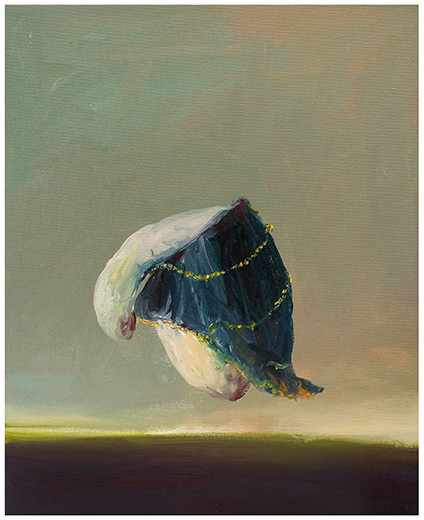C39. 2018.
Joseba Eskubi
* 1967 in Bilbao
Oil on canvas. 41 x 33 cm.
Signed and dated.
€ 1250.-
It is an equally strange world that can be found in the work of
Bilbao-based Spanish artist Joseba Eskubi, though his is one that is
attached to reality by the thinnest of threads. Known for his weird and
wonderfully amorphous forms, Eskubi is an artist whose imagery is highly
evocative whilst never quite becoming the things it evokes. What might
be suggestive of a butterfly could also call to mind a ballerina’s
dress, the body of an insect might also be a precious item of jewellery,
what might be perceived as a bird could equally be an ornament. Curious
clumps of matter are presented in surprising configurations, the
organic and the inorganic intertwined in such strange ways that the
viewer can never be entirely sure if they are looking at something
living, something that once lived, or something that has never been
alive. They are neither fish nor fowl. There is also the rather
disturbing possibility that the things he paints have been brought to
life by unnatural means – as if through magic or witchcraft. Indeed,
there is some- thing distinctly totemic, or talismanic, about many of
Eskubi’s paintings – feathers and hair, fabric and stones, limbs and
flesh conspiring to suggest exotic fetishes from civilisations unknown.
In
many works, these mysterious objects float in the air, suspended
against a backdrop of pure or muddied colours – from black to putty,
murky pink to rusty orange, dingy blue to sickly yellow. On other
occasions, the objects are set in a landscape of sorts, with almost
abstract bands of land, sea, horizon and sky variously merging and
separating. While the Earth offers great variety in the colours of the
natural environment, the geology of Eskubi’s landscapes often feels to
be not of this world, as though we are looking at the surfaces of
planets in distant galaxies. In some instances, the viewer is left to
ponder the scale of the imagery depicted – are we looking at a large
object in the distance, or a small object close up? As our minds
struggle to rationalise the object itself, our under- standing of the
environment surrounding it is destabilised, resulting in conflicting
sensations of intimacy and detachment, proximity and perspective.
Similarly,
the viewer would be justified if they felt uncertain as to the weight
of Eskubi’s creations – some heavy-looking forms appear to float with
ease, while other lighter- looking things seem to hover just above the
ground, or to be on, or buried in, the surface. Rocks that might be
animals, fantastical creatures that might be masquerading as flotsam and
jetsam from the delirious mind of a rogue taxidermist, and billowing
apparitions that threaten to take on human form are just part of
Eskubi’s lexicon, a language of amorphous matter evolving towards the
biomorphic and anthropomorphic, a language of odd dreams on the cusp of
turning into nightmares. These things, these beings, are often so close
to being human they appear to have the proportions of the body, complete
with limbs, heads and sometimes even faces, yet there always remains
something not quite human, not quite fully conscious about them. (...)
there is a sense in Eskubi’s work that we are not looking through
rational eyes at the real world, but rather through a filter of sleep,
or of the subconscious, or of fantasy. In painting we are perhaps always
looking at an illusion, and even in the darkest corners of abstraction,
we are inevitably entering a liminal space that is just beneath
reality.
Mathew Price, 2019
